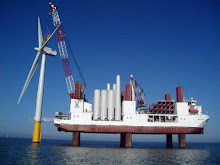Kamis, 21 Mei 2009
Why Wind Energy
Why wind energy ?
... for a sustainable development of both the economy and the environment
The importance to realise sustainable development, both economically wise as well as environmentally wise is evident but certainly no easy goal to fulfil. Wind energy can help.
Firstly, it is a clean source of energy with no emission of CO2 (carbon dioxide, the main greenhouse gas) or any other pollutant associated with fossil fuels (coal, gas, oil) or nuclear power. The energy pay back time of a wind turbine either on shore or at sea is only three to six months.
Secondly, wind resources are vast, particularly offshore locations and rural areas offer a great potential. For example, the world's wind energy resource is more than twice the expected total electricity demand in 2020. The great potential of clean wind energy, combined with its continuously improving price competitiveness makes it a key contributor to replace fossil fuels. It will thereby help to prevent economic disruptions once the economic exploitation of fossil fuels comes to an end and will assist to realise a sustainable environment.
... for industry and employment
Over the last decades wind energy has seen a spectacular development. Commercial machines have grown in size from ten kilowatt (five meter rotor diameter) to more than 45,000 kilowatt (more than 120 meter diameter) today. During the past five, six years the installed wind power in the world has increased with more than 30% annually. In 2020, according to predictions by EWEA and Greenpeace, the global amount of wind energy will be sufficient for 12% of the world's electricity consumption. This implies an increase of the installed wind power from about 31 gigawatt by the end of 2002 to 1,260 gigawatt in 2020 world wide (around 23% annually).
However, the total employment both direct and indirect in the wind industry increases less than proportional with the installed wind power because of efficiency improvements in design, manufacture, and installation. The employment is expected to reduce from twenty jobs per megawatt installed wind power to 9.8 jobs per megawatt in 2020. Following these projections by EWEA and Greenpeace the total employment in the wind energy sector will grow from approximately 114 thousand jobs in 2001 to 1.47 million jobs in 2020.
R&D and political challenges
As indicated above, wind energy is a fast growing source of renewable energy increasingly contributing to a stable economic development. However, in order to maintain or even further improve the opportunities for wind energy it is of eminent importance to invest in R&D and political framework.
Important actions lie in the field of improving the cost-competitiveness of wind energy, the exploitation of new sites for wind farms like e.g. at sea and in developing countries, and also efforts need to be made to remove non-tangible barriers for the implementation of wind power such as uncertainty about incentives, wearisome legislation procedures, and the lack of knowledge regarding environmental issues. Moreover, instruments and international agreements that aim to protect the environment are an important driving force for wind energy.
Topical technical challenges are among others the reliable upscaling of wind turbine and wind farm size (taking advantage of the economy of scale), improvement of turbine availability, power quality and grid connection aspects, and the accurate prediction of wind farm power output up to 24 hours in advance.
from ECN
